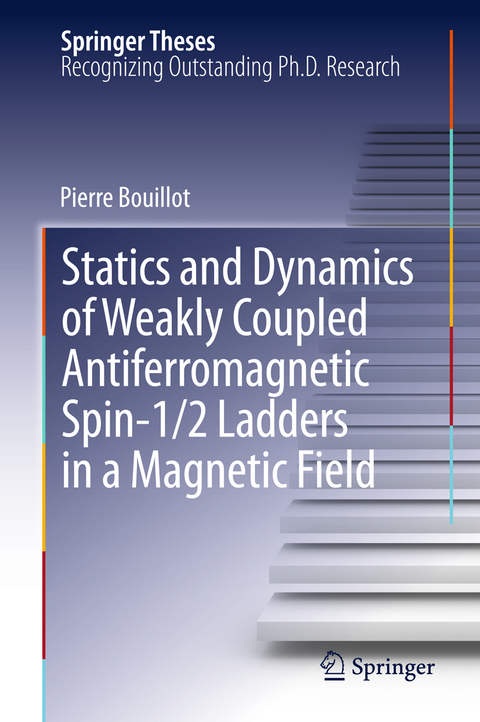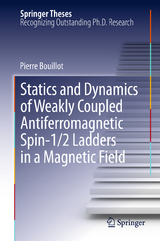Statics and Dynamics of Weakly Coupled Antiferromagnetic Spin-1/2 Ladders in a Magnetic Field
Seiten
2012
|
2013
Springer Berlin (Verlag)
978-3-642-33807-6 (ISBN)
Springer Berlin (Verlag)
978-3-642-33807-6 (ISBN)
This book shows how a combination of techniques such as a time dependent and finite temperature Density Matrix Renormalization Group technique, can be used to obtain the physical properties of low dimensional quantum magnets with unprecedented accuracy.
This thesis shows how a combination of analytic and numerical techniques, such as a time dependent and finite temperature Density Matrix Renormalization Group (DMRG) technique, can be used to obtain the physical properties of low dimensional quantum magnets with an unprecedented level of accuracy. A comparison between the theory and experiment then enables these systems to be used as quantum simulators; for example, to test various generic properties of low dimensional systems such as Luttinger liquid physics, the paradigm of one dimensional interacting quantum systems. Application of these techniques to a material made of weakly coupled ladders (BPCB) allowed the first quantitative test of Luttinger liquids. In addition, other physical quantities (magnetization, specific heat etc.), and more remarkably the spins-spin correlations - directly measurable in neutron scattering experiments - were in excellent agreement with the observed quantities. We thus now have tools to quantitatiivelyassess the dynamics for this class of quantum systems.
This thesis shows how a combination of analytic and numerical techniques, such as a time dependent and finite temperature Density Matrix Renormalization Group (DMRG) technique, can be used to obtain the physical properties of low dimensional quantum magnets with an unprecedented level of accuracy. A comparison between the theory and experiment then enables these systems to be used as quantum simulators; for example, to test various generic properties of low dimensional systems such as Luttinger liquid physics, the paradigm of one dimensional interacting quantum systems. Application of these techniques to a material made of weakly coupled ladders (BPCB) allowed the first quantitative test of Luttinger liquids. In addition, other physical quantities (magnetization, specific heat etc.), and more remarkably the spins-spin correlations - directly measurable in neutron scattering experiments - were in excellent agreement with the observed quantities. We thus now have tools to quantitatiivelyassess the dynamics for this class of quantum systems.
Dr. Pierre Bouillot University of Geneva DPMC-MaNEP 1211 Geneva Switzerland e-mail: bouillot@bluewin.ch affiliation: University of Geneva, Switzerland
Introduction.- Spin-1/2 ladders.- Methods.- Static properties and NMR relaxation rate.- Dynamical correlations of a spin ladder.- Conclusions and perspectives.
| Erscheint lt. Verlag | 14.12.2012 |
|---|---|
| Reihe/Serie | Springer Theses |
| Zusatzinfo | X, 98 p. |
| Verlagsort | Berlin |
| Sprache | englisch |
| Maße | 155 x 235 mm |
| Gewicht | 348 g |
| Themenwelt | Naturwissenschaften ► Chemie ► Analytische Chemie |
| Naturwissenschaften ► Physik / Astronomie ► Quantenphysik | |
| Naturwissenschaften ► Physik / Astronomie ► Theoretische Physik | |
| Technik ► Maschinenbau | |
| Schlagworte | BPCB • Density matrix renormalization group • Dynamical Correlation Function • Low Dimensional Quantum Magnets • Luttinger liquids • One-dimensional Quantum Magnets • Quantum Simulators • Time-dependent Density Matrix Renormalization Grou • Time-dependent Density Matrix Renormalization Group • TLL Universality Class • Tomonaga-Luttinger Liquid • Weakly Coupled Ladders |
| ISBN-10 | 3-642-33807-0 / 3642338070 |
| ISBN-13 | 978-3-642-33807-6 / 9783642338076 |
| Zustand | Neuware |
| Haben Sie eine Frage zum Produkt? |
Mehr entdecken
aus dem Bereich
aus dem Bereich




